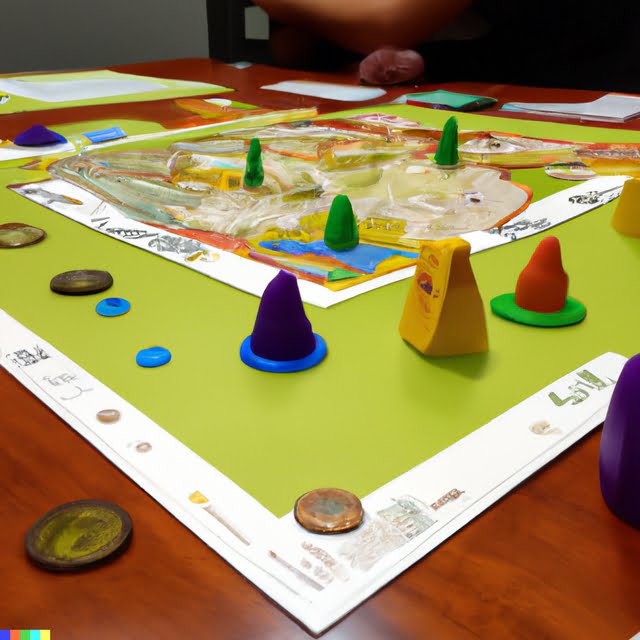Introduction
Teaching a new board game can be great fun! Not only do you get to learn something new, it also allows for friendly competition among your family and friends. Plus, it also has the added health benefits of stimulating your mind, which leads to increased analytical thinking and problem-solving skills. It’s also perfect when you’re in need of some quality time with those closest to you. So before getting into the play-by-play rules of a new game, consider discussing these advantages of why it’s important to give a new game a try.
Setting Up the Board
When teaching a new board game, it is important to explain how to set up the board and provide clear instructions for doing so. Start by unpacking the board and separating all components (e.g., tokens, playing cards, separate boards, etc.). After organizing these components into groups, explain the purpose for each group (i.e., why they’re needed) and then demonstrate how they should be connected and/or assembled within the game. Make sure all players understand what they need to do as they build the game together so that everyone can join in on the task.
Once everything is properly setup on the board, be sure to explain the overall structure of the game so everyone knows what to expect. Include information such as who will go first? How many turns each person has per round? When do you draw cards or pick a token? What rules are enforced during playtime? This information will help keep things running smoothly as people gradually learn how to play. Finally, create an atmosphere that encourages learning as mistakes are inevitable when playing a new board game from time-to-time. A friendly competitive spirit can help build camaraderie amongst players while still having fun with each other!
Explaining the Mechanics
Teaching a new board game involves more than just reading through the rules; it’s important to take extra steps to ensure everyone understands how the game works and what they must do in order to win. When introducing players to a new game, start by explaining the mechanics of the game, such as what objectives the players are working towards and any special strategies that could be used. Make sure everyone grasps the basic premise of how pieces interact with one another, since understanding this will help them later on when making decisions in-game. Consider going beyond that though – if there are special rules or strategies players can use to their advantage, be sure they’re aware of it too. Don’t forget to explain any specialized components of the game, such as additional decks or dice-rolls that are used for certain activities like trading or building settlements. Even if it’s a relatively simple board game, reviewing all the details with the players before starting is key!
Clarifying Questions
When teaching a new board game, it is important to address any common questions or concerns the players may have. Doing so will help the players to understand the game and can minimize confusion. If a rule seems unclear, go over it in greater detail and offer examples when necessary. Make sure everyone understands how the board works and explain how each sector of the board interacts with the other areas. It’s also important to clarify which items are necessary for play and how they’re used during gameplay. Additionally, it’s beneficial to discuss what victory conditions are in place so that everyone knows how to win. Explanations of any unique terms or phases of the game should be outlined as well so that players are clear on them before starting play. Ultimately, by addressing these common questions and concerns about the game mechanics, you will help ensure that everyone can learn the game quickly and enjoy playing it more efficiently!
Involving Everyone
When teaching a new board game, it’s important to consider the different age ranges of players. Some games require more skill and strategy than others and may be too difficult for young children. Take into account the ages of each person so that they all enjoy playing while being challenged appropriately.
Communication is key to any successful game night. Use short explanations and provide plenty of opportunities for questions throughout your teaching process. Demonstrate how the game works by playing an example round with everyone involved in order to ensure that everyone understands! Showing examples of turns can also be helpful for visual learners.
In addition, keep it fun! Enlist the help of someone who is excited about the new game you’re introducing and allow them to join on your team when you demonstrate – this will create an atmosphere where all players are engaged and enjoying itself instead of feeling like they’re being made to take part in something they don’t want to do. Additionally, use upbeat music or give rewards like stickers and small prizes after each round completed in order to encourage progress and maintain interest in participatory learning. By involving everyone, you can make sure even your youngest players have a good time at game night!
Finishing the Game
Explaining how to finish the game is an important part of teaching a new board game. Make sure they understand that the game is over when someone has reached the agreed upon goal, or when players have decided it’s time to stop. Once the game has ended, you can thank everyone for their enthusiasm and effort, emphasizing any skills or strategies that were used throughout. If something didn’t work out quite how you wanted it to, use this as a learning opportunity for next time. Encourage constructive criticism and collaborative ideas for how the game can be improved in future games by offering positive feedback. Finally, top off the activity with a round of applause from all players to celebrate your successes!
Afterthoughts
When teaching a new board game, it is important to wrap up with reflections and insights gained from the experience. It is useful for people to reflect on the different strategies they used, think about how their decisions impacted the gameplay, and discuss any big wins or losses that occurred throughout the game. People should also be encouraged to share what surprised them during gameplay and how they overcame any challenges that arose. This is a great opportunity for people to gain insight into their decision-making processes and assess how well they worked in order to be better prepared the next time they play. Additionally, if playing with experienced players, this reflection time could be used as an opportunity to glean advice and tips that could help improve gameplay. Ultimately, these reflections at the end of the game will ensure everyone wholeheartedly enjoys playing and gains something valuable from the experience.

I love playing all kinds of games – from classics like Monopoly to modern favourites like Ticket to Ride.
I created this blog as a way to share my love of board games with others, and provide information on the latest releases and news in the industry.





